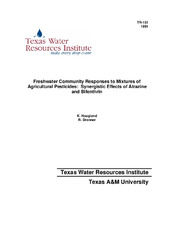| dc.description.abstract | This study was an investigation of the effects of the herbicide atrazine and the insecticide bifenthrin on lake communities. The study was conducted in two phases: in phase one, we examined the effects of environmentally realistic levels of atrazine and bifenthrin, based on published data of concentrations measured in fresh waters; in phase two, the impacts of higher levels of atrazine and bifenthrin were investigated, based on concentrations used in previous studies. The factorial designed experiment included three levels of bifenthrin (0, 1/39, and 1/287 ngL in phase one and 0, 1/125, and 1/3150 ngL in phase two) cross-classified with three levels of atrazine (0, 1/15, and 1/153 ugL in phase one and 0, 1/385, and 1/2167 ugL in phase two), with duplicate replication of each treatment combination. Pesticides were added to 5,500 L fiberglass tanks containing natural plankton assemblages and bluegill. Tanks were sampled 7 and 14 d following the first pesticide treatment and 7 d after the second pesticide addition.
In phase one of the study, atrazine significantly reduced chlorophyll concentrations and turbidity on day 7 Wand had no significant impact on primary productivity or algal cell densities. Atrazine also had a significant negative effect on copepod nauplii and rotifers (days 7 and 14) and on Bosmina and particulate phosphorus in the 20-200 um size fraction (day 14). Bifenthrin significantly reduced Bosmina (days 7 and 14), cyclopoid copepodids (days 7 and 14), and copepod nauplii (day 14), however bifenthrin increased rotifers at day 7. Bifenthrin addition also increased colonial green algae and decreased particulate phosphorus in the 20-200 um size fraction on day 7 and decreased turbidity and particulate phosphorus in the >200 um size fraction on days 7 and 14. Only one fish mortality (in the high bifenthrin, no atrazine treatment combination) occurred during phase one of the study. Significant interaction effects were found only for Bosmina (day 14), rotifers (day 7), and turbidity (days 7 and 14), indicating that at the concentrations used in phase one of this study, these agricultural pesticides did not act synergistically.
In phase two, higher levels of atrazine resulted in significant reductions in primary productivity, chlorophyll, green colonies, Bosmina, rotifers, and particulate phosphorus (>200 um and 20-200 um) on day 7. Bifenthrin had a negative impact on Bosmina, copepod nauplii, rotifers, primary productivity, chlorophyll, green colonies, and all particulate phosphorus fractions. In addition, 33% bluegill mortality was observed in treatment combinations with an average maximum concentration of 1/3150 ngL bifenthrin. The interaction effects found indicated that when either compound was introduced at ecologically realistic levels, its effects were essentially masked if the other toxicant was present at high concentrations. | en |


